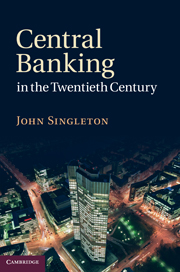Book contents
- Frontmatter
- Contents
- List of illustrations
- Acknowledgements
- List of abbreviations
- 1 A beginner's guide to central banking
- 2 Very boring guys?
- 3 Wind in the willows: the small world of central banking c. 1900
- 4 Something for everyone: new central banks, 1900–1939
- 5 A series of disasters: central banking, 1914–1939
- 6 The mysteries of central bank cooperation
- 7 The first central banking revolution
- 8 No time for cosmic thinkers: Central banking in the ‘Keynesian’ era
- 9 Rekindling central bank cooperation in the Bretton Woods era
- 10 The goose that lays the golden egg: Central banking in developing countries
- 11 The horse of inflation
- 12 The second central banking revolution: Independence and accountability
- 13 Reputations at stake: financial deregulation and instability
- 14 Inflation targeting: the holy grail?
- 15 The long march to European monetary integration
- 16 A world with half a million central bankers
- References
- Index
12 - The second central banking revolution: Independence and accountability
Published online by Cambridge University Press: 04 February 2011
- Frontmatter
- Contents
- List of illustrations
- Acknowledgements
- List of abbreviations
- 1 A beginner's guide to central banking
- 2 Very boring guys?
- 3 Wind in the willows: the small world of central banking c. 1900
- 4 Something for everyone: new central banks, 1900–1939
- 5 A series of disasters: central banking, 1914–1939
- 6 The mysteries of central bank cooperation
- 7 The first central banking revolution
- 8 No time for cosmic thinkers: Central banking in the ‘Keynesian’ era
- 9 Rekindling central bank cooperation in the Bretton Woods era
- 10 The goose that lays the golden egg: Central banking in developing countries
- 11 The horse of inflation
- 12 The second central banking revolution: Independence and accountability
- 13 Reputations at stake: financial deregulation and instability
- 14 Inflation targeting: the holy grail?
- 15 The long march to European monetary integration
- 16 A world with half a million central bankers
- References
- Index
Summary
So complete is the consensus which now exists over the desirability of central bank independence that it is possible to forget how quickly it emerged.
James Forder (2005: 843–4)In your deliberations on the future charter for central banking in Europe, I commend to you the example of New Zealand – though in so doing, I am conscious that my remarks may sound somewhat arrogant in view of the shortness of our history of central banking, and the recent nature of our adoption of the framework.
Don Brash, Governor of the RBNZ, at Bank of England Tercentenary Symposium, 1993 (Brash 1994: 315)The doctrine of central bank independence (CBI), as developed in the 1980s and 1990s, acquired an almost mystical status. The growing emphasis on CBI was one of the two principal characteristics of the second revolution in central banking, the other being inflation targeting. Central banks attained a higher level of prestige and influence in the 1990s than at any time since the 1920s. According to McNamara (2002), at least thirty-eight countries were granted ‘legal’ CBI between 1989 and 1999. Her list includes developed, developing, and transitional countries, but not those where CBI assumed a less formal character.
CBI is a difficult concept to define and measure; the associated concepts of accountability and transparency are no less slippery. Forder argues that ‘those with the most to gain from central bank independence are central banks’ (Forder 2002: 52). Yet the most ardent proponents of CBI were academic economists and politicians.
- Type
- Chapter
- Information
- Central Banking in the Twentieth Century , pp. 204 - 221Publisher: Cambridge University PressPrint publication year: 2010



